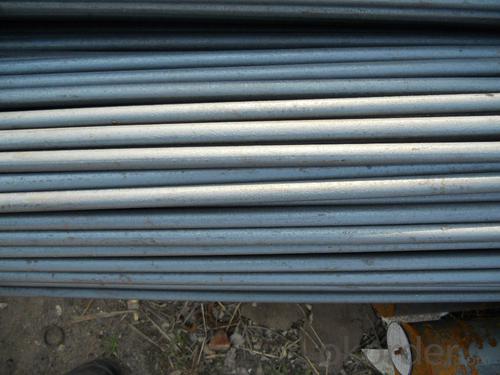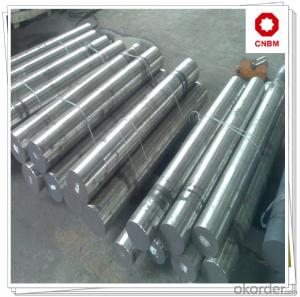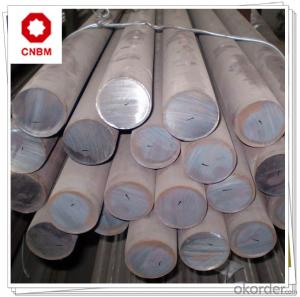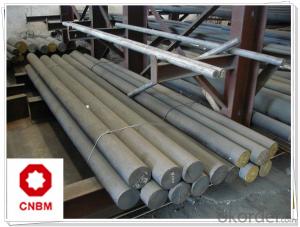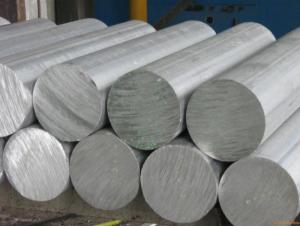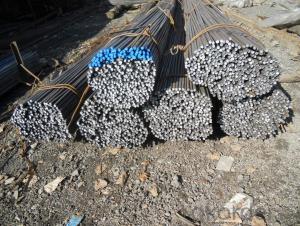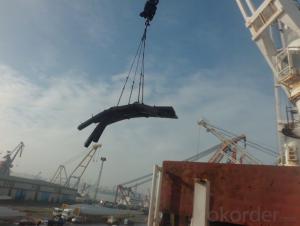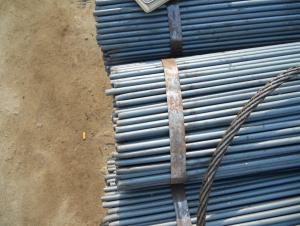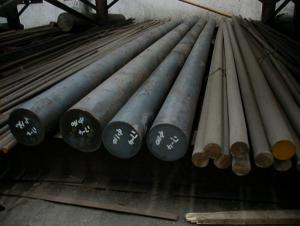HOT ROLLED ROUND BAR
- Loading Port:
- China Main Port
- Payment Terms:
- TT OR LC
- Min Order Qty:
- -
- Supply Capability:
- -
OKorder Service Pledge
OKorder Financial Service
You Might Also Like
Specifications of Wire Rod Q235:
Steel Grade: Q235, Standard: GB Diameter: 5.5mm, 6.5mm, 7mm,8mm,9mm,10mm,12mm,14mm
Diameter Tolerance:±0.3mm 6.5mm can be drawing into 2mm/8.0mm can be drawing into 3mm
Brand Name: N-RIVER Place of Origin: Hebei, China Mainland Application: construction, building etc
Chemical Composition:
Please kindly find our chemistry of our material based on Q235 as below for your information
Trademark | Rank | Chemical composition (quality score) % | | ||||
C | Si | Mn | S | P | | ||
| | |||||||
| ≤ |
| ≤ | ≤ | | ||
Q235 | A | 0.14-0.22 | 0.30 | 0.30-0.65 | 0.050 | 0.045 | |
Q235 | B | 0.12-0.20 | 0.30 | 0.30-0.70 | 0.045 | 0.045 | |
Trademark | Rank | Pulling Test | | ||||
Bend PointΔs/Mpa | Tensile Strength | Elongation Ratioδ5% | | ||||
| | |||||||
Thickness (Diameter) /MM | Thickness (Diameter) /MM | | |||||
≤16 | 16-40 | | ≤16 | 16-40 | | ||
≥ | | ≥ | | ||||
Q235 | A | 235 | 225 | 375-500 | 26 | 25 | |
Q235 | B | 235 | 225 | 375-500 | 26 | 25 | |
Usage and Applications of Wire Rod Q235:
After hot-rolled the products shaped into coil and delivery as finished product, including round, square, rectangular, hexagonal and so on. Since most of the products are round, it is generally called wire rod. Carbon steel wire rod is widely used in construction and manufacturing. Carbon steel wire rod is mainly used for reinforcement of reinforced concrete and welded structure or reprocessed (roberts , nail, etc.) materials, especially used to produce wire drawing, welding electrode, nails, spring, electronic, precise machinery parts and so on.
Packaging & Delivery of Wire Rod Q235:
Packaging Detail: products are packed in coil and then shipped by container or bulk vessel
Each coil weight: 2-3MT
Delivery Detail: within 45 days after received deposit or LC.
Label: to be specified by customer, generally, each bundle has 1-2 labels
Trade terms: FOB, CFR, CIF
- Q: Can steel round bars be used in the manufacturing of mining equipment?
- Yes, steel round bars can be used in the manufacturing of mining equipment. Steel round bars are often used as a raw material in the fabrication of various components and parts for mining equipment due to their high strength, durability, and resistance to wear and tear. These bars can be machined, forged, or welded into different shapes and sizes to meet the specific requirements of mining equipment, such as drill bits, conveyor systems, crushers, and support structures.
- Q: Can steel round bars be used for making stabilizer bars?
- Yes, steel round bars can be used for making stabilizer bars. Steel round bars are commonly used in various industries, including automotive, for their high strength and durability. Stabilizer bars require materials that can withstand heavy loads and provide stability, making steel round bars an ideal choice for their construction.
- Q: How do you measure the hardness of a steel round bar?
- The hardness of a steel round bar can be measured using various methods, with the most common being the Rockwell hardness test. In this test, a diamond or steel ball indenter is pressed into the surface of the steel at a specific load, and the depth of the indentation is measured. The hardness value is determined based on the depth of the indentation and the applied load. Other methods like Brinell and Vickers hardness tests can also be used, depending on the specific requirements and characteristics of the steel.
- Q: Can steel round bars be used in the production of industrial machinery?
- Yes, steel round bars can be used in the production of industrial machinery. Steel round bars are commonly used in the manufacturing of various components and parts for industrial machinery due to their strength, durability, and versatility. These bars can be used to create shafts, gears, rollers, and other critical components that are essential for the proper functioning of industrial machinery. The high tensile strength of steel round bars allows them to withstand heavy loads and resist deformation, making them ideal for use in industrial applications. Additionally, steel round bars can be easily machined, welded, and formed into different shapes and sizes, making them highly suitable for customization according to specific machinery requirements.
- Q: Can steel round bars be used for making conveyor belts or rollers?
- No, steel round bars are not typically used for making conveyor belts or rollers. Conveyor belts and rollers are usually made from materials such as rubber, polyurethane, or other flexible and durable materials that can withstand the constant movement and friction involved in conveying items.
- Q: Are steel and round steel the same thing?
- Yuan steel and round steel are the same thing, they are round steel.
- Q: How do steel round bars differ from steel square bars?
- The shape and appearance of steel round bars and steel square bars differ. Steel round bars have a circular cross-section and a cylindrical shape, making them suitable for applications that require strength and stability, such as construction, manufacturing, and engineering. Their circular shape allows for even distribution of stress and load, making them highly resistant to bending or twisting forces. They are commonly used as structural components in buildings, support beams, shafts, and axles. On the other hand, steel square bars have a square cross-section with four equal sides and sharp corners. This shape provides additional advantages in certain applications. Square bars offer better grip and handling due to their flat surfaces, making them easier to hold, stack, or secure during fabrication or installation. They are often utilized in the manufacturing of machinery, tools, frames, and brackets where square edges are necessary for precise alignment or stability. Both steel round bars and steel square bars are available in various grades and alloys, providing different levels of strength, hardness, and corrosion resistance. The choice between the two depends on the specific requirements of the project or application.
- Q: What are the different mechanical properties of steel round bars?
- The different mechanical properties of steel round bars include tensile strength, yield strength, elongation, hardness, and impact resistance. Tensile strength refers to the maximum amount of stress a material can withstand before breaking. Yield strength is the stress at which a material begins to deform permanently. Elongation measures the amount of deformation a material can undergo before breaking. Hardness determines the material's resistance to indentation or scratching. Impact resistance is the ability of a material to absorb energy during sudden impacts without breaking.
- Q: What are the different types of steel round bar surface treatments?
- There are several different types of surface treatments that can be applied to steel round bars to enhance their appearance, durability, and resistance to corrosion. Some of the most common surface treatments include: 1. Hot-dip galvanizing: This process involves immersing the steel round bar in a bath of molten zinc to create a protective zinc coating. This coating helps to prevent rust and corrosion, making it ideal for outdoor applications. 2. Electroplating: Electroplating involves coating the steel round bar with a layer of another metal, such as chrome or nickel. This not only enhances the appearance of the bar but also improves its resistance to corrosion. 3. Powder coating: In this process, a dry powder is applied to the surface of the steel round bar electrostatically and then cured under heat. This creates a hard, durable, and attractive finish that is resistant to chipping, scratching, and fading. 4. Passivation: Passivation is a chemical process that removes impurities from the surface of the steel round bar, leaving behind a clean and corrosion-resistant layer. This treatment is commonly used for stainless steel bars to enhance their resistance to rust. 5. Black oxide coating: Black oxide coating is a conversion coating that forms a thin layer of black iron oxide on the surface of the steel round bar. This treatment provides mild corrosion resistance and also gives the bar a sleek black appearance. 6. Shot blasting: Shot blasting involves propelling abrasive materials at high speeds onto the surface of the steel round bar to remove any impurities or scale. This treatment not only improves the appearance but also creates a roughened surface that promotes better adhesion of coatings. 7. Acid pickling: Acid pickling is a process that removes scale and impurities from the surface of the steel round bar by immersing it in an acid bath. This treatment leaves the surface clean and free from any contaminants. These are just a few examples of the various surface treatments available for steel round bars. The choice of treatment depends on factors such as the intended use of the bar, the desired appearance, and the level of corrosion resistance required.
- Q: What are the different shapes available for steel round bars?
- Steel round bars are available in various shapes to suit different applications. The most common shapes include: 1. Round: This is the most basic and widely used shape for steel round bars. It is cylindrical in shape and has a circular cross-section. Round bars are used in a wide range of industries such as construction, automotive, and manufacturing. 2. Square: Square steel round bars have a square cross-section. They are often used in applications that require added strength and stability, such as structural support columns, fences, and ornamental ironwork. 3. Hexagonal: Hexagonal steel round bars have six sides and a hexagonal cross-section. They offer a good balance of strength and versatility and are commonly used in applications such as machine parts, fasteners, and tooling. 4. Flat: Flat steel round bars have a rectangular cross-section with a narrow width and thick height. They are commonly used in construction and manufacturing for applications such as braces, brackets, and supports. 5. Half-round: Half-round steel round bars have a semi-circular cross-section. They are often used in architectural and decorative applications such as handrails, edging, and trim work. These are some of the most common shapes available for steel round bars. The choice of shape depends on the specific requirements of the application, including strength, stability, and aesthetics.
Send your message to us
HOT ROLLED ROUND BAR
- Loading Port:
- China Main Port
- Payment Terms:
- TT OR LC
- Min Order Qty:
- -
- Supply Capability:
- -
OKorder Service Pledge
OKorder Financial Service
Similar products
Hot products
Hot Searches
Related keywords



